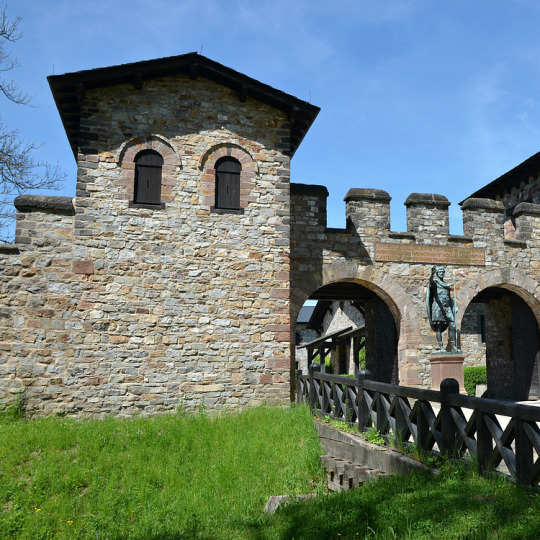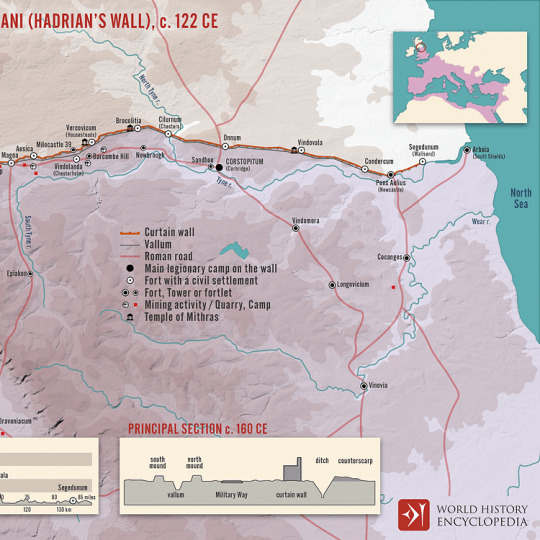#RomanWarfare
Photo

Organisation of the Roman Imperial Army
An infographic illustrating the hierarchical structure and divisions within the military land force of the Roman Empire (c. 27 BCE - 480 CE). The Imperial Roman Army was a formidable force, instrumental in the empire's expansion, consolidation, and maintenance. Divided into legions (around 28 at most times), each comprising thousands of disciplined, standardly equipped, highly-trained soldiers skilled in various combat techniques and proficient in the use of weapons, the army of the Roman Empire emerged as the dominant power of the ancient world.
Image by Simeon Netchev
102 notes
·
View notes
Photo

Mark Antony's Parthian Campaign
In 36 BCE, Mark Antony (83-30 BCE) invaded Parthia, hoping to render himself one of the great conquerors of the Greco-Roman world, but he was stymied by Parthian forces and obliged to undertake an arduous, costly retreat. What to make of this reversal was a major issue then – and remains so now.
Continue reading...
24 notes
·
View notes
Photo

A Visitor's Guide to Rome's Frontier in Germany
In the 2nd century CE, the Roman Empire stretched from Scotland in northern Europe to the deserts of southern Egypt, encompassing the entirety of the Mediterranean basin. Beyond that lay its borders. Where there was no natural frontier such as rivers, mountains, deserts, or sea, the Romans constructed artificial barriers.
Continue reading...
42 notes
·
View notes
Photo

Social War
The Social War (also called the Marsi War and well as the War of the Allies) of 91-87 BCE was the result of decades of contention between Rome and its Italian allies. Roman warfare relied heavily on the Italian allies (socii), but the Roman Republic did not grant them citizenship. The main cause of the Social War was this inequality in status.
Causes
This tension had its beginnings at the very onset of the Roman expansion across the Italian peninsula. Between 500 and 275 BCE, the citizen armies of the Roman Republic brought Latium and the remainder of the peninsula under its thumb. While allowing these newly acquired allies limited self-government, Rome demanded one thing from them: loyalty. This loyalty brought with it a distinct benefit for Rome: an unlimited supply of manpower for its military campaigns. As Rome reached across the Mediterranean with its long arms into Spain, Greece, North Africa, and Asia, its demand for manpower increased. As Rome demanded more and more from its Italian allies, the tension grew with it.
Continue reading...
37 notes
·
View notes
Photo

Rome's Defeat at the Battle of Teutoburg Forest
At the Battle of Teutoburg Forest in 9 CE, a rag-tag barbarian force annihilated three Roman legions, leaving the Roman emperor Augustus (27 BCE to 14 CE) to nightly wander his palace, shouting for the defeated commander, Publius Quinctilius Varus, to give him back his legions. The defeat not only stopped the growth of the Roman Empire but also created the Latin-Germanic divide that persists in Western Europe to this day.
Continue reading...
55 notes
·
View notes
Photo

Vallum Hadriani (Hadrian’s wall), c. 122 CE
A map illustrating the span, structure, and context of the 73 miles (118 km) Hadrian's Wall (also called the Vallum Aelii, Aelius being the family name of emperor Hadrian). Built by a force of more than 15,000 soldiers from the three roman legions stationed in Britain, with an intent "to separate the Romans from the barbarians" (the Picts and other tribes to the north of Britain), the wall defined the northern frontier of the Roman Empire along the Tyne–Solway isthmus and created a military zone full of forts, milecastles, ramparts, roads, barracks and bustling settlements from the North Sea to the Irish Sea.
51 notes
·
View notes
Photo

The Siege of Jerusalem in 70 CE
The Siege of Jerusalem in 70 CE was the high watermark in the First Jewish-Roman War (66-73 CE) regarding the tension between the two forces. With the Roman Empire transitioning from the Julio-Claudian emperors to the Flavian dynasty in the middle of 69 CE, there was much pressure to quell the rebellion across Judaea.
Continue reading...
42 notes
·
View notes
Photo

Legions of Late Antiquity
The Roman army underwent dramatic changes in Late Antiquity. Civil war and external conflicts led to the creation of new legions while existing legions were either split or disbanded. Although there was an increase in the number of legions, these legions were much smaller. Field armies numbered around 1,000 to 2,000, while cavalry units were around 600.
Continue reading...
36 notes
·
View notes
Photo

Interview: Rome Strategy of Empire by James Lacey
In this interview, World History Encyclopedia sits down with author James Lacey to chat about his new book Rome: Strategy of Empire published by Oxford University Press.
Continue reading...
18 notes
·
View notes
Photo

Legio XXI Rapax
Legio XXI Rapax was a legion of the Roman army whose name name "Rapax" means "rapacious" or "greedy". It is not clear when the legion assumed this name; it may or may not be the same 21st legion Julius Caesar (100-44 BCE) formed before his Gallic Wars and the 21st commanded by Mark Antony (83-30 BCE). Roman emperor Augustus (r. 27 BCE - 14 CE) also formed 21st.
Continue reading...
61 notes
·
View notes
Photo

Roman Warfare in the Age of Pyrrhus
The Roman army fought many conflicts throughout its long history, though perhaps none so indelible as the Pyrrhic War from 280-275 BCE. This war between Rome and a league of Greek colonies in southern Italy led by the city of Tarentum marks a significant turning point in the Mediterranean world, effectively demonstrating the superiority of Roman political and military policy.
Continue reading...
37 notes
·
View notes
Photo

Legions of Moesia
The province of Moesia was vital to the Roman military’s protection of the Balkans. Subdued by the Roman commander Marcus Licinius Crassus in 29 BCE, it was initially part of Macedonia. Due to its location along the Danube, it became essential during the Dacian Wars of both emperors Domitian (r. 81-96 CE) and Trajan (r. 98-117 CE).
Continue reading...
46 notes
·
View notes
Photo

Legions of Noricum, Raetia & Dacia
The provinces Noricum, Raetia, and Dacia served as a buffer protecting Roman Empire against any possible outside threat. However, the region posed several internal problems for Rome: Pannonia and its ally Dalmatia rebelled against Roman occupancy, causing a three-year war, and Moesia was invaded by the Dacians during the reigns of both Domitian (r. 81-96 CE) and Trajan (r. 98-117 CE) while.
Continue reading...
27 notes
·
View notes
Photo

A Visitor's Guide to Rome's Frontier in Germany
In the 2nd century CE, the Roman Empire stretched from Scotland in northern Europe to the deserts of southern Egypt, encompassing the entirety of the Mediterranean basin. Beyond that lay its borders. Where there was no natural frontier such as rivers, mountains, deserts, or sea, the Romans constructed artificial barriers.
Continue reading...
47 notes
·
View notes
Photo

Legio IX Hispana
Legio IX Hispana served with Julius Caesar in Gaul and against Pompey in the Civil Wars. Later, it fought alongside Augustus in his Cantabrian Wars and was one of the four legions Claudius took with him in his invasion of Britain in 43 CE. It survived mutiny and near decimation twice, only to recover. Although suffering heavy losses during the revolt of Boudicca, the legion rebounded and accompanied Agricola in his war against the Caledonians. The legion disappeared sometime after 120 CE.
Continue reading...
45 notes
·
View notes
Photo

Legio X Fretensis
Legio X Fretensis was a legion of the Roman army formed by either Julius Caesar or Augustus. The legion spent most of its existence in the East, primarily in Judea. It participated in Corbulo’s two Armenian campaigns as well as Vespasian and Titus’ battle against the Great Jewish Revolt of 66 CE, besieging both Jerusalem and Masada.
Continue reading...
29 notes
·
View notes